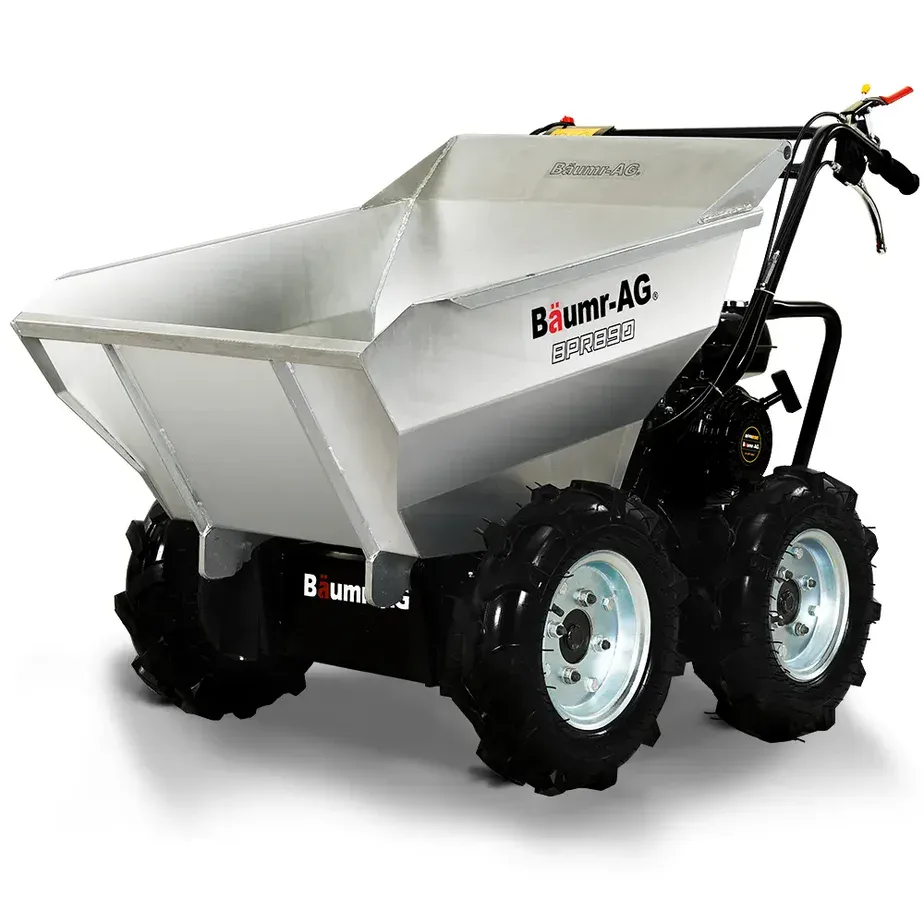BAUMR-AG 6.5HP Mini Dumper: Power Barrow Guide for Aussies
Ever tried moving a mountain of mulch, firewood, or sand on a boiling hot day—and felt like you’d never get it done? Or maybe you’re out on the fireground, clearing a blackened fence line, and your crew is wrecked from wheelbarrowing loads uphill, again and again. Whether you’re looking after your home, working a tough job, or supporting your local fire brigade, making hard work easier is a game-changer. That’s where the BAUMR-AG 6.5HP Mini Dumper Power Barrow comes in.
This guide will show you how this petrol-powered barrow with a galvanised bucket can help Aussies of all backgrounds—renters, families, businesses, and emergency services—work smarter, not harder. We’ll cover safe use, smart prep, common mistakes, real-life fireground and household examples, plus tips for packing, planning, and getting the best from your gear. Whether you’re brand new or an old hand, you’ll find practical advice for every job. Let’s dig in.
If you want to see the exact specs, check out the official BAUMR-AG 6.5HP Mini Dumper Power Barrow.
This is the model featured in our guide—rugged, petrol-driven, and ready for big loads whether you’re prepping your backyard, working on-site, or backing up your crew during emergencies.
Why a Mini Dumper? Real-World Uses Across Australia
If you’ve ever tried shifting dirt, sand, rocks, firewood, or gear with a shovel and a barrow, you know how much sweat it takes. Petrol-powered mini dumpers like the BAUMR-AG aren’t just for tradies—they’re a smart upgrade for anyone managing land, gardens, or busy worksites. You’ll see them everywhere from suburban backyards to rural blocks, fire stations, and remote community halls.
For families and property owners, a mini dumper can save your back (and your weekends) by moving heavy stuff fast—think landscaping, storm clean-ups, shed rebuilds, and bushfire prep. For fire crews and volunteers, these machines shine in mop-up work, hazard reduction, moving hoses or foam drums, and shifting debris safely—especially on sloped or muddy ground. Even renters can benefit for big clean-ups, garden makeovers, or shared projects with mates.
What sets the BAUMR-AG apart is its petrol engine, galvanised bucket, four-wheel drive, and sturdy construction—meaning you can tackle rough ground, wet paddocks, or tricky access without drama.
Key Features of the BAUMR-AG 6.5HP Mini Dumper
Moves up to 300kg per load—much more than any manual barrow—without straining your back.
Resists rust and dings, even when carrying firewood, bricks, or wet mulch.
Gets traction on mud, gravel, slopes, and uneven ground—crucial for both home and fireground use.
Fits through garden gates, around sheds, and into tight work areas most larger machines can’t reach.
It’s a machine that’s just as happy shifting soil in a small suburban yard as it is clearing burnt logs after a bushfire or loading sandbags during a flood response. And because it’s petrol-powered, you’re not limited by battery run time or tangled extension cords.
Getting Ready: Safe Preparation for Every User
Whether you’re a first-timer or an experienced crew member, the first step is always preparation. Most incidents and accidents with machinery come down to skipped checks, rushing, or guessing at the controls. Here’s what works:
- Read the manual—yes, even if you’re “good with engines.” Know your controls, brakes, and tipping system before starting.
- Wear solid boots, long pants, gloves, and eye protection—splinters, rocks, and sharp tools love to find bare skin.
- Fuel up with fresh petrol. Stale fuel leads to poor starts and headaches. Always store fuel safely away from ignition sources.
- Check for oil leaks, loose bolts, and tyre pressure (or track tension). A loose part can mean downtime or injury later.
- Clear your route. Remove hoses, cables, pets, or children from the work area. For fire crews: always scan for hazards like embers, nails, and slippery ash.
- Plan your load. Never overfill or pile materials too high—spills cause more cleanup and can unbalance the barrow on slopes.
Tip: If you’re working with a team, have a quick “toolbox talk” before firing up the engine. Set clear roles—one person operates, others help load and spot hazards. For families, involve kids in prep (safely) so they learn respect for machinery early.
Step-by-Step – Using the Mini Dumper Like a Pro
At Home or On the Block
- Start up safely. Engage neutral, turn the ignition, and let the engine warm up for a minute. Listen for odd noises—rattles or smoke mean stop and check.
- Load evenly. Place heavy items at the front (nearest the bucket), lighter ones on top. Don’t overload the barrow; steady and safe always beats rushing.
- Plan your path. Walk your route first. Mark out steep sections, tight turns, or places you need a spotter.
- Drive at a steady pace. Keep both hands on the controls. Watch your feet—especially when reversing or near ditches.
- Unload safely. Come to a complete stop, check for people or pets, and tip the bucket slowly. Don’t yank or force the handle.
- Switch off and secure. After the job, idle the engine for a minute, then turn off. Clean off mud and debris—your machine will last years longer if it’s well cared for.
On the Fireground or Worksite
On tough jobs—clearing after a fire, stacking sandbags, or hauling salvage—add these steps:
- Work in pairs: One operator, one spotter (especially near fire edges, ditches, or sharp drop-offs).
- Check for hot spots: Never park over embers or ash—tyres and tracks can ignite or melt.
- Watch fatigue: Regular breaks reduce mistakes. Rotate drivers every 30–40 minutes.
- Use for safe gear transport: Move hoses, water drums, hand tools, and even first aid kits securely—don’t overload or let items bounce out.
On big jobs, keeping a radio or mobile phone handy is a good idea. Even the best equipment can get bogged, so never work completely alone if you can help it.
Safety Tips and Common Mistakes (Everyone Makes Them!)
The good news? Most mini dumper “disasters” are preventable—and they’re usually the same handful of mistakes, whether you’re new to machinery or you’ve been at it for years. Here’s what to watch for:
It’s not about being perfect—it’s about building good habits, and learning from little mishaps before they become big problems. If something goes wrong, stop, breathe, and work through it calmly. If in doubt, call for help (from your crew, a mate, or a professional).
For Households, Renters, and Small Businesses
Not everyone’s managing a big property or a fireground, but the BAUMR-AG is still a handy upgrade for smaller blocks, city gardens, and even rental homes. Think about seasonal clean-ups (leaf fall, storm debris), shifting compost or garden waste, and helping neighbours in need.
- Renters: Use the barrow for end-of-lease clean-ups, garden makeovers, or moving mulch/soil for raised beds. Return it clean and refuelled if you’re borrowing or hiring.
- Small businesses: Landscapers, handymen, and cleaners can finish jobs faster and take on bigger projects without wearing out staff.
- Elderly or disabled users: Team up with family, friends, or support workers. Always work in pairs if possible, and stick to flat, clear routes.
Tip: If you’re not confident operating the dumper solo, ask a local hire company for a demo. Most are happy to show you the basics before you rent or buy.
For Fire Crews and Emergency Services
On the fireground or in disaster clean-up, a petrol mini dumper like the BAUMR-AG is more than a convenience—it’s a force multiplier. It helps preserve energy, speed up logistics, and keep firefighters safer by reducing fatigue.
- Shifting hose coils, foam drums, or water containers: Quicker than carrying by hand, and less risk of sprains or slips.
- Debris removal after a burn or storm: Load up burnt fence posts, roof tin, or tree limbs for fast, safe removal.
- Mop-up gear transport: Move rakes, shovels, and extra PPE to crew members on distant sectors.
- Sandbag deployment: Carry heavy sandbags to strategic spots without risking back injuries.
Always brief your crew on safe operation, set a clear work area, and rotate drivers. Make it part of your post-incident check to clean and refuel the dumper for the next job.
Packing, Storage, and Maintenance
A well-looked-after dumper will last for years, even with tough Aussie conditions. Here’s how to keep yours in top shape:
Tip: Make a simple maintenance log (paper or in your phone) to track oil changes, repairs, and cleaning. It’ll pay off when you need warranty support or want to sell later.
Little-Known Tips and Lessons from the Field
- Cold weather starts: On frosty mornings, use the choke, and let the engine warm up fully before loading heavy gear.
- Wet ground: If tracks or wheels spin, don’t force it—unload some weight, or use boards/gravel for traction.
- Emergency stop: Know where the kill switch is. Teach everyone who might operate the barrow how to stop it fast in an emergency.
- Night use: Attach a battery LED work light if you’re working after dark—but never block your own view or the controls.
- Sharing with neighbours or brigade: Set a shared cleaning and refuelling routine to avoid conflict and breakdowns.
Many small incidents happen because of simple oversights—like letting a pet or child approach the dumper, or leaving the bucket raised when parking. Take two extra minutes, and you’ll prevent almost every mishap.
More Guides for Safer, Smarter Working
- Want to keep your gear in top shape? Read our Best Practices for Cleaning Firefighting Gear.
- New to bushfire prep? Try our Step-by-Step Bushfire Preparation Guide.
- Want a smarter shed or work setup? See our Kincrome Ute Box Organiser Review.



